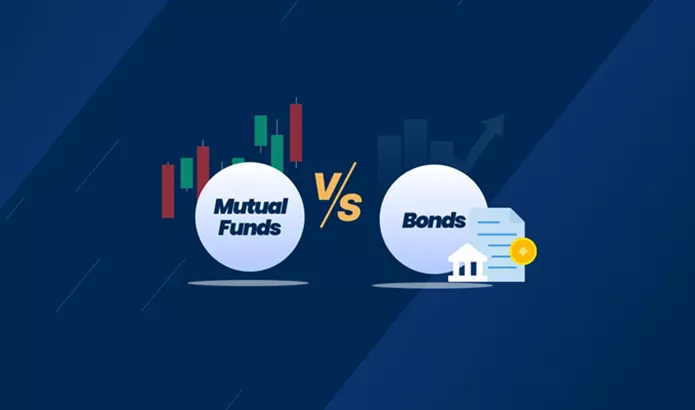Investing can be a powerful way to grow your wealth over time. Two popular options are bonds and mutual funds. Each has its own benefits and risks. Understanding these can help you make better investment choices.
This article will explain the differences between bonds and mutual funds. We’ll look at how they work, their pros and cons, and which might be better for you. Whether you’re new to investing or looking to diversify your portfolio, this guide will provide clear and simple information.
What Are Bonds?
Bonds are loans that you give to governments or companies. In return, they promise to pay you interest over time and return your money at the end of the bond’s term.
Types of Bonds
– Government Bonds: Issued by national governments. They are considered very safe.
– Municipal Bonds: Issued by local governments. They often offer tax benefits.
– Corporate Bonds: Issued by companies. They usually offer higher interest rates but come with more risk.
How Bonds Work
When you buy a bond, you’re lending money. The issuer agrees to pay you interest, usually every six months, and return the full amount at maturity. For example, if you buy a $1,000 bond with a 5% interest rate, you’ll receive $50 each year until the bond matures.
Advantages of Bonds
– Steady Income: Bonds provide regular interest payments.
– Lower Risk: Especially with government bonds, the risk of losing money is low.
– Capital Preservation: Bonds can help protect your initial investment.
Disadvantages of Bonds
– Lower Returns: Compared to stocks or mutual funds, bonds often yield less.
– Interest Rate Risk: If interest rates rise, bond prices can fall.
– Inflation Risk: Inflation can reduce the purchasing power of your interest payments.
What Are Mutual Funds?
Mutual funds pool money from many investors to buy a diversified portfolio of stocks, bonds, or other assets. A professional manager oversees the fund.
Types of Mutual Funds
– Stock Funds: Invest mainly in stocks.
– Bond Funds: Invest mainly in bonds.
– Balanced Funds: Invest in a mix of stocks and bonds.
– Money Market Funds: Invest in short-term, low-risk securities.
How Mutual Funds Work
When you invest in a mutual fund, you buy shares of the fund. The value of your investment changes with the value of the fund’s holdings. Mutual funds are priced once a day, after the market closes.
Advantages of Mutual Funds
– Diversification: Spreads risk across many investments.
– Professional Management: Experts manage the fund’s investments.
– Accessibility: You can start investing with a small amount of money.
Disadvantages of Mutual Funds
– Fees: Management fees can reduce your returns.
– Less Control: You don’t choose the individual investments.
– Tax Implications: You may owe taxes on distributions, even if you reinvest them.
Comparing Bonds and Mutual Funds
Returns
– Bonds: Offer fixed interest payments. Returns are predictable but usually lower.
– Mutual Funds: Returns vary based on the fund’s performance. Potential for higher returns, especially with stock funds.
Risk
– Bonds: Generally lower risk, especially government bonds.
– Mutual Funds: Risk varies. Stock funds are riskier; bond funds are less so.
Liquidity
– Bonds: Can be sold before maturity, but may not get full value.
– Mutual Funds: Can be sold at the end of any trading day at the current price.
Fees
– Bonds: May have transaction fees when buying or selling.
– Mutual Funds: Management fees and other expenses can apply.
Tax Considerations
– Bonds: Interest is usually taxed as regular income. Some municipal bonds are tax-exempt.
– Mutual Funds: Taxes on dividends and capital gains distributions.
Which Is Better for You?
Your choice depends on your financial goals, risk tolerance, and investment horizon.
Choose Bonds If:
– You want steady, predictable income.
– You’re risk-averse.
– You’re nearing retirement and want to preserve capital.
Choose Mutual Funds If:
– You’re seeking higher returns.
– You’re comfortable with some risk.
– You prefer professional management and diversification.
Combining Both in Your Portfolio
Many investors use both bonds and mutual funds to balance risk and return. For example, you might invest in bond funds for income and stock mutual funds for growth.
Getting Started
If you’re new to investing, consider exploring the Investment Fund Market for a variety of options. For beginners, the Fund Market For Beginners offers resources to help you start.
Conclusion
Both bonds and mutual funds have their place in an investment strategy. Bonds offer stability and income, while mutual funds offer growth potential and diversification. Assess your financial goals and risk tolerance to decide which is better for you. Often, a combination of both can provide a balanced approach to investing.
Related topics:


